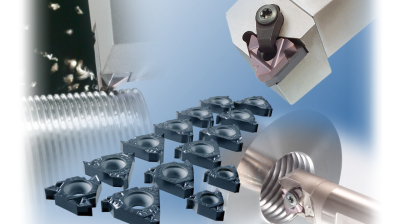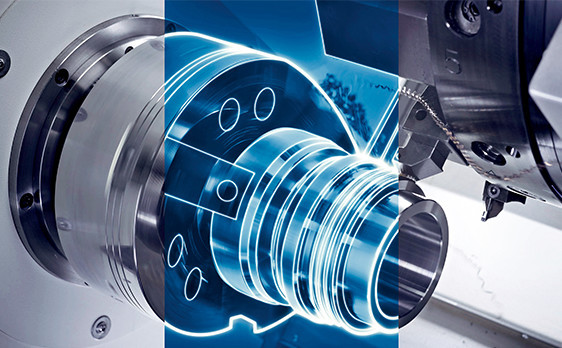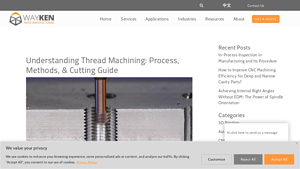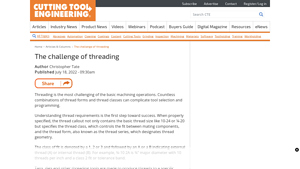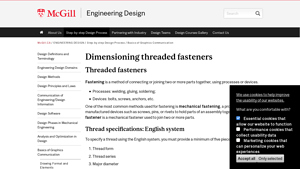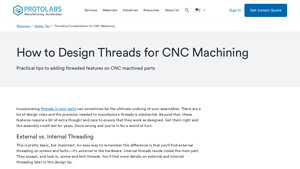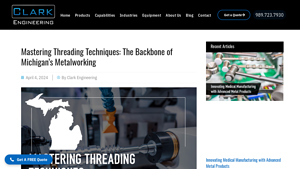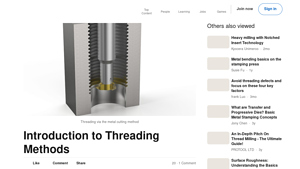Threading Engineering Guide: Type, Cost, Top List…
Introduction: Navigating the Global Market for threading engineering
Navigating the intricate landscape of threading engineering poses a significant challenge for international B2B buyers seeking reliable and cost-effective solutions. As threads serve as crucial coupling agents in various machined parts, understanding the nuances of thread types, applications, and machining processes is essential for informed sourcing. This comprehensive guide delves into the diverse world of threading engineering, covering everything from the various types of threads—such as internal and external—to the latest machining methods and industry standards.
In this guide, you will explore critical aspects like supplier vetting to ensure quality and compliance, cost considerations to maximize your budget, and best practices for selecting the appropriate threading tools. By equipping yourself with this knowledge, you can make strategic purchasing decisions that not only meet your technical requirements but also align with your business goals.
This resource is particularly tailored for B2B buyers from Africa, South America, the Middle East, and Europe, including markets like Vietnam and Germany, where specific threading standards and practices can vary widely. With a focus on actionable insights and expert guidance, this guide aims to empower you to navigate the global market for threading engineering confidently, ensuring your projects are executed seamlessly and successfully.
Understanding threading engineering Types and Variations
| Type Name | Key Distinguishing Features | Primary B2B Applications | Brief Pros & Cons for Buyers |
|---|---|---|---|
| Internal Threads | Cut into the interior of a part, typically using taps. | Fasteners, fittings, and inserts | Pros: Excellent for secure assembly; Cons: Limited to specific applications. |
| External Threads | Formed on the outer surface of parts, often via lathe work. | Screws, bolts, and studs | Pros: Versatile across various industries; Cons: Requires precise cutting tools. |
| Unified Threads | Standardized thread forms (UNC, UNF) for compatibility. | General manufacturing and assembly | Pros: Widely accepted and easy to source; Cons: May not fit specialized applications. |
| Tapered Threads | Conical shape for enhanced sealing, often used in plumbing. | Oil and gas, plumbing connections | Pros: Provides strong seals; Cons: Can complicate manufacturing processes. |
| British Standard Whitworth (BSW) | Older standard thread form, not widely used today. | Vintage machinery repairs | Pros: Essential for legacy equipment; Cons: Difficult to source compatible tools. |
What Are Internal Threads and Their Applications in B2B?
Internal threads, often referred to as female threads, are machined into the inside of a component using taps. These threads are crucial in applications where secure fastening is necessary, such as in the assembly of automotive and aerospace parts. B2B buyers should consider the specific requirements for thread size and pitch, as well as the materials involved, to ensure compatibility with external fasteners. While internal threads provide excellent assembly security, they are limited to applications requiring screw insertions.
How Do External Threads Differ and What Are Their Uses?
External threads, commonly known as screw threads, are created on the outer surfaces of components, typically using lathe machines. They are widely utilized in the production of screws, bolts, and studs, making them essential in various industries, including construction and manufacturing. B2B buyers must ensure precision in cutting these threads, as any inaccuracies can lead to assembly issues. While external threads offer versatility, they require specific tooling, which can impact production costs.
What Are Unified Threads and Their Importance for Buyers?
Unified threads, which include both Unified National Coarse (UNC) and Unified National Fine (UNF) designs, are standardized thread forms that facilitate compatibility across different manufacturers. This standardization is particularly beneficial in general manufacturing and assembly processes, where interchangeable parts are crucial. B2B buyers should prioritize unified threads for their ease of sourcing and compatibility. However, buyers should be cautious, as standardized threads may not suit specialized applications requiring unique thread forms.
What Are Tapered Threads and Their Key Benefits in Industry?
Tapered threads feature a conical design that enhances sealing capabilities, making them ideal for applications in the oil and gas industry, as well as plumbing connections. These threads are designed to create a tight seal that prevents leaks, which is critical in high-pressure environments. When purchasing tapered threads, B2B buyers should consider the specific industry standards that apply, as these can vary significantly. While tapered threads provide robust sealing solutions, they may complicate manufacturing processes due to their unique geometry.
What Is the Relevance of British Standard Whitworth Threads in Modern Manufacturing?
British Standard Whitworth (BSW) threads represent an older standard that is not commonly used in contemporary manufacturing. However, they are still vital for repairing vintage machinery and equipment that utilize this thread form. B2B buyers in niche markets or industries should be aware of the need for compatible tools and parts when dealing with BSW threads. While these threads are essential for legacy equipment maintenance, sourcing compatible tools can be challenging and may lead to increased costs.
Key Industrial Applications of threading engineering
| Industry/Sector | Specific Application of threading engineering | Value/Benefit for the Business | Key Sourcing Considerations for this Application |
|---|---|---|---|
| Oil & Gas | Threaded connections for piping and valves | Ensures leak-proof and safe operation | Compliance with API standards, material quality, and durability |
| Automotive | Manufacturing of bolts and screws for assembly | Enhances structural integrity and performance | Precision in thread specifications, availability of standards |
| Construction | Fasteners for structural components | Provides stability and safety in construction | Corrosion resistance, load-bearing capacity, and certification |
| Aerospace | Threaded components for aircraft assembly | Critical for safety and reliability | Strict adherence to aerospace standards and material specifications |
| Electronics | Precision threaded connectors for devices | Facilitates compact and efficient designs | Compatibility with existing systems, precision machining, and reliability |
How is Threading Engineering Applied in the Oil & Gas Industry?
In the oil and gas sector, threading engineering is crucial for creating secure threaded connections in piping and valves. These connections must be leak-proof to ensure safety and compliance with industry regulations. International buyers must prioritize sourcing materials that meet API standards for durability and corrosion resistance. Additionally, understanding the specific thread forms required for different applications is essential to avoid costly failures in the field.
What Role Does Threading Engineering Play in Automotive Manufacturing?
Threading engineering is integral to the automotive industry, particularly in the production of bolts and screws used in vehicle assembly. These fasteners must meet stringent specifications to ensure structural integrity and performance under various conditions. Buyers in this sector should focus on precision in thread specifications, as well as sourcing from suppliers who can provide standardized components that meet international automotive standards.
How is Threading Engineering Utilized in Construction Projects?
In construction, threading engineering finds application in manufacturing fasteners that secure structural components. The reliability of these threaded connections is vital for the stability and safety of buildings and infrastructure. For international buyers, sourcing fasteners that offer corrosion resistance and high load-bearing capacity is critical, especially in regions with harsh environmental conditions. Certification and compliance with local construction codes also play a significant role in the procurement process.
Why is Threading Engineering Important in Aerospace Applications?
Aerospace applications require the utmost precision in threading engineering for components such as bolts and screws used in aircraft assembly. The safety and reliability of these components are paramount, making adherence to strict aerospace standards essential. Buyers must ensure that suppliers can meet specific material specifications and thread geometry requirements to avoid catastrophic failures. Additionally, the sourcing process should consider the supplier’s track record in delivering high-quality, certified components.
How is Threading Engineering Applied in the Electronics Sector?
In the electronics industry, threading engineering is employed to create precision threaded connectors that facilitate compact designs in various devices. These connectors must be reliable and compatible with existing systems to ensure optimal functionality. International buyers should seek suppliers who specialize in precision machining and can provide products that meet the specific requirements of their designs. Reliability and quality assurance are crucial factors in the sourcing process to prevent device failures.
3 Common User Pain Points for ‘threading engineering’ & Their Solutions
Scenario 1: Navigating Complex Thread Specifications
The Problem:
B2B buyers often encounter difficulties when it comes to understanding and specifying thread requirements for their projects. The complexity of different thread forms, classes, and standards can lead to significant miscommunications between engineering teams and suppliers. For instance, a buyer may order a certain thread size but neglect to specify the thread class, resulting in products that do not fit with existing components. This oversight can cause delays in production, increased costs due to rework, and frustration for all parties involved.
The Solution:
To overcome this challenge, it is crucial for buyers to thoroughly understand their thread specifications. Begin by investing in training for your engineering and procurement teams to familiarize them with common thread standards such as UNC, UNF, and others relevant to your industry. Always include detailed thread specifications in your purchase orders, including the thread size, class, and form. Utilizing tools such as thread gauges can help ensure that the correct specifications are met before components are manufactured. Additionally, fostering a collaborative relationship with suppliers can allow for clearer communication regarding thread requirements, reducing the risk of errors and ensuring that the right products are delivered on time.
Scenario 2: Choosing the Right Threading Tools and Techniques
The Problem:
Another common pain point arises when B2B buyers struggle to select the appropriate threading tools and techniques for their specific applications. With a myriad of options available, including cut and formed threads, as well as various types of taps and dies, it can be overwhelming to determine the best approach. This indecision can lead to poor thread quality, increased production times, and ultimately, dissatisfied customers.
The Solution:
To address this issue, buyers should conduct a comprehensive analysis of their threading needs before making any tooling decisions. Begin by assessing the materials you will be working with and the specific requirements of your application, such as load-bearing capacity and environmental conditions. Once you have a clear understanding of your requirements, consult industry resources like Machinery’s Handbook to gain insights into the best practices for threading. Furthermore, consider collaborating with tool manufacturers who can provide guidance on the most suitable tools for your needs. They often have expertise in recommending the right threading techniques and can offer valuable insights into optimizing your machining processes. Regularly reviewing and updating your tooling inventory based on feedback from production can also enhance efficiency and product quality.
Scenario 3: Managing Production Delays Due to Threading Issues
The Problem:
Production delays caused by threading issues can severely impact a company’s bottom line. Problems such as incorrect thread depth, pitch, or diameter can lead to rejected parts and wasted materials. For instance, a company may discover that a batch of parts has been produced with incorrect thread dimensions only after the components have been manufactured, leading to significant rework and extended lead times.
The Solution:
To mitigate the risk of production delays, it is essential to implement a robust quality control process specifically tailored for threading operations. Start by introducing regular inspections during the machining process, using go/no-go gauges to verify that thread dimensions conform to specifications. Additionally, invest in high-quality threading tools that are designed to minimize errors during production. Leveraging CNC technology can also enhance precision and consistency in thread cutting, reducing the likelihood of errors. Lastly, establishing a feedback loop where operators can report threading issues in real time can help identify patterns and areas for improvement. By proactively addressing threading challenges, companies can maintain smoother production flows and enhance overall operational efficiency.
Strategic Material Selection Guide for threading engineering
What Are the Key Materials Used in Threading Engineering?
When selecting materials for threading engineering, it is essential to consider the specific requirements of the application, including mechanical properties, environmental conditions, and regulatory compliance. Below, we analyze four common materials used in threading applications: carbon steel, stainless steel, aluminum, and brass. Each material has unique properties, advantages, and limitations that influence their suitability for various applications.
How Does Carbon Steel Perform in Threading Applications?
Key Properties: Carbon steel is known for its strength and hardness, making it suitable for high-stress applications. It can withstand moderate temperatures and pressures, although it has limited corrosion resistance unless treated.
Pros & Cons: The primary advantage of carbon steel is its cost-effectiveness and excellent machinability. However, its susceptibility to rust and corrosion can be a significant drawback, particularly in humid or corrosive environments. This necessitates additional protective coatings, which can increase manufacturing complexity.
Impact on Application: Carbon steel threads are ideal for applications where strength is paramount, such as in automotive and construction sectors. However, their limited corrosion resistance means they are unsuitable for marine or chemical environments.
Considerations for International Buyers: Buyers should ensure compliance with standards such as ASTM A307 for carbon steel fasteners. In regions like Europe and the Middle East, awareness of local corrosion risks is crucial, as is adherence to relevant safety and quality standards.
What Advantages Does Stainless Steel Offer for Threading?
Key Properties: Stainless steel is renowned for its excellent corrosion resistance and ability to withstand high temperatures. It is available in various grades, each offering different mechanical properties.
Pros & Cons: The key advantage of stainless steel is its durability and resistance to oxidation, making it suitable for a wide range of applications, including food processing and chemical industries. However, it is generally more expensive than carbon steel and can be more challenging to machine due to its toughness.
Impact on Application: Stainless steel threads are particularly advantageous in environments exposed to moisture or corrosive substances. They are commonly used in plumbing, marine applications, and medical devices.
Considerations for International Buyers: Compliance with standards such as ASTM A193 or DIN 1.4401 is essential for stainless steel products. Buyers in regions like Africa and South America should be aware of local regulations regarding food safety and corrosion resistance.
How Does Aluminum Compare in Threading Engineering?
Key Properties: Aluminum is lightweight and has good corrosion resistance, making it suitable for applications where weight savings are critical. It has lower strength compared to steel but offers excellent machinability.
Pros & Cons: The primary advantage of aluminum is its lightweight nature, which can significantly reduce overall product weight. However, its lower strength limits its use in high-stress applications, and it can be more expensive than carbon steel.
Impact on Application: Aluminum threads are commonly used in aerospace and automotive applications where weight is a critical factor. They are also suitable for electrical components due to their conductivity.
Considerations for International Buyers: Buyers should be familiar with standards such as ASTM B211 for aluminum alloys. In Europe, compliance with EN standards is critical, especially for aerospace applications.
What Role Does Brass Play in Threading Applications?
Key Properties: Brass is an alloy of copper and zinc, known for its excellent corrosion resistance and good machinability. It has a moderate strength level and is often used in decorative applications due to its aesthetic appeal.
Pros & Cons: The key advantage of brass is its resistance to corrosion and tarnishing, making it ideal for plumbing and electrical applications. However, it is more expensive than carbon steel and may not be suitable for high-stress environments.
Impact on Application: Brass threads are commonly used in plumbing fixtures, electrical connectors, and decorative hardware. Its corrosion resistance makes it suitable for applications involving water or other corrosive media.
Considerations for International Buyers: Compliance with standards such as ASTM B16 for brass fittings is essential. Buyers in regions like the Middle East should consider local water quality and its impact on material selection.
Summary Table of Material Selection for Threading Engineering
| Material | Typical Use Case for threading engineering | Key Advantage | Key Disadvantage/Limitation | Relative Cost (Low/Med/High) |
|---|---|---|---|---|
| Carbon Steel | Automotive and construction applications | Cost-effective and strong | Susceptible to corrosion | Low |
| Stainless Steel | Marine and food processing applications | Excellent corrosion resistance | Higher cost and machining difficulty | High |
| Aluminum | Aerospace and automotive lightweight parts | Lightweight and good machinability | Lower strength | Medium |
| Brass | Plumbing fixtures and electrical connectors | Corrosion resistant and aesthetic | More expensive and less strong | Medium |
This strategic material selection guide provides valuable insights for international B2B buyers in various regions, ensuring informed decisions in threading engineering applications.
In-depth Look: Manufacturing Processes and Quality Assurance for threading engineering
What Are the Key Stages in the Manufacturing Process for Threading Engineering?
Threading engineering encompasses various manufacturing processes that require precision and attention to detail. Understanding these stages is crucial for B2B buyers looking to source high-quality threaded components. The typical manufacturing process for threading involves several main stages: material preparation, forming, assembly, and finishing.
How is Material Prepared for Threading Engineering?
Material preparation is the foundational step in the threading manufacturing process. It involves selecting the appropriate raw materials, such as steel, aluminum, or plastic, based on the final application of the threaded components. Materials must be inspected for defects, ensuring they meet specified standards before proceeding.
Once the material is selected, it undergoes cutting to the desired length, followed by processes such as heat treatment or surface hardening, which enhance the material’s strength and durability. Proper preparation is essential, as any imperfections can affect the integrity of the threaded parts.
What Forming Techniques Are Commonly Used in Threading Engineering?
Forming techniques are critical in creating internal and external threads. The two primary methods are cutting and forming.
-
Cutting Threads: This traditional method involves removing material from a workpiece using tools like taps for internal threads and dies for external threads. CNC (Computer Numerical Control) machining centers are commonly used to achieve high precision and repeatability. The threading tools must be selected based on the specific thread form and class required for the application.
-
Forming Threads: This method displaces material rather than removing it. Thread rolling is a common technique where the workpiece is passed between two dies that impart the thread shape. This method often results in stronger threads due to the work-hardening effect on the material.
Both methods require skilled machinists who understand the nuances of thread geometry and the specific requirements of each project.
How is Assembly Handled in Threading Engineering?
After the threading process, assembly may be required, especially in applications where multiple threaded components interact. This stage involves fitting the threaded parts together, which necessitates precise tolerances to ensure proper function.
For assemblies that require additional strength, techniques such as welding or adhesive bonding may be employed. Quality checks during assembly are crucial to ensure that components fit correctly and operate as intended.
What Finishing Processes Are Important in Threading Engineering?
Finishing processes enhance the performance and aesthetic of threaded components. Common finishing techniques include:
- Deburring: This process removes sharp edges and burrs that can affect the functionality and safety of the components.
- Surface Treatment: Techniques such as anodizing, plating, or coating can improve corrosion resistance and wear properties.
- Precision Measurement: Utilizing measuring instruments like micrometers and gauges ensures that the finished threads meet the required specifications.
These finishing processes are vital for ensuring that the final product performs reliably in its intended application.
What Quality Assurance Practices Are Essential for Threading Engineering?
Quality assurance (QA) is a critical aspect of threading engineering, ensuring that products meet international standards and customer specifications. Adhering to quality assurance practices helps mitigate risks associated with defective components, which can lead to costly rework or failures.
Which International Standards Should B2B Buyers Be Aware Of?
B2B buyers should be familiar with various international quality standards relevant to threading engineering. ISO 9001 is a widely recognized standard that outlines the requirements for a quality management system. Compliance with this standard indicates that a manufacturer consistently meets customer and regulatory requirements.
Industry-specific standards, such as those from the American Petroleum Institute (API) for oil and gas applications, are also critical. These standards dictate specific requirements for thread forms and materials to ensure safety and performance in demanding environments.
What Are the QC Checkpoints Throughout the Manufacturing Process?
Quality control checkpoints are essential for maintaining product integrity throughout the manufacturing process. Key checkpoints include:
- Incoming Quality Control (IQC): Inspecting raw materials upon arrival to ensure they meet specifications.
- In-Process Quality Control (IPQC): Monitoring operations during manufacturing to identify any deviations from standards. This includes regular measurements of thread dimensions and tolerances.
- Final Quality Control (FQC): Conducting thorough inspections of finished products before shipping. This may involve functional testing and dimensional checks using specialized gauges.
Implementing these checkpoints helps manufacturers identify and rectify issues early in the process, reducing waste and improving overall quality.
How Can B2B Buyers Verify Supplier Quality Control Practices?
B2B buyers must take proactive steps to verify the quality control practices of their suppliers. Here are several effective methods:
-
Supplier Audits: Conducting on-site audits allows buyers to evaluate a supplier’s quality management system and manufacturing processes firsthand. This includes reviewing documentation, observing operations, and interviewing staff.
-
Quality Reports: Requesting detailed quality reports, including inspection results and non-conformance reports, provides insight into the supplier’s performance and adherence to standards.
-
Third-Party Inspections: Engaging third-party quality inspectors can offer an unbiased evaluation of a supplier’s processes and products. This is particularly important for international transactions, where buyers may not have direct oversight.
-
Certifications: Buyers should verify that suppliers possess relevant certifications, such as ISO 9001 or industry-specific certifications like API, to ensure compliance with quality standards.
What Are the QC and Certification Nuances for International B2B Buyers?
For international B2B buyers, understanding the nuances of quality control and certification is crucial. Different regions may have varying standards and practices, which can impact sourcing decisions. Buyers from Africa, South America, the Middle East, and Europe should be aware of these factors:
- Regulatory Compliance: Familiarity with local regulations and standards is essential, as non-compliance can lead to legal issues or product recalls.
- Cultural Differences: Understanding the cultural context of suppliers can aid in better communication and expectations regarding quality.
- Logistical Considerations: International shipping can complicate quality assurance. Buyers should ensure that suppliers have robust processes for handling shipping and customs to maintain product integrity.
By taking these factors into account, B2B buyers can effectively navigate the complexities of sourcing threaded components internationally, ensuring they receive high-quality products that meet their specifications.
Practical Sourcing Guide: A Step-by-Step Checklist for ‘threading engineering’
Introduction
This guide serves as a practical checklist for B2B buyers engaged in sourcing threading engineering services or components. Given the complexity of threading requirements and the diverse range of suppliers available, following these steps will help ensure you make informed decisions that align with your technical specifications and business needs.
Step 1: Define Your Technical Specifications
Clearly articulating your technical requirements is crucial. This includes the type of threads needed (internal or external), thread form (e.g., UNC, UNF), pitch, and diameter. Providing detailed specifications helps potential suppliers understand your needs and reduces the risk of errors during manufacturing.
- Consider industry standards: Familiarize yourself with applicable standards such as ISO or API, particularly if you operate in specialized sectors like oil and gas.
- Specify tolerances: Ensure you define the fit class (1, 2, or 3) to control the precision required in your applications.
Step 2: Research and Shortlist Potential Suppliers
Start by compiling a list of potential suppliers specializing in threading engineering. Look for companies with a strong reputation in your industry and region.
- Utilize industry directories: Platforms like ThomasNet or industry-specific forums can provide valuable insights into qualified suppliers.
- Check for experience: Focus on suppliers who have experience with similar projects or industries to yours, as they will better understand your unique challenges.
Step 3: Evaluate Supplier Capabilities
Once you have shortlisted potential suppliers, assess their technical capabilities. This includes their machinery, technology, and expertise in threading processes.
- Request information on equipment: Ensure they have modern CNC machines capable of producing high-precision threads.
- Inquire about threading methods: Different suppliers may specialize in either cutting or forming threads; understanding their strengths will help you align your needs.
Step 4: Verify Supplier Certifications
Before finalizing your decision, confirm that the suppliers possess relevant certifications that demonstrate their commitment to quality and safety.
- Look for ISO certifications: ISO 9001 certification indicates a quality management system that meets international standards.
- Check industry-specific certifications: Depending on your industry, certifications from organizations like API or ASME may also be necessary.
Step 5: Request Samples and Prototypes
Before placing a large order, request samples or prototypes of the threaded components. This step allows you to evaluate the quality and precision of the supplier’s work firsthand.
- Test for fit and function: Ensure that the samples meet your specifications and fit seamlessly with your existing components.
- Assess surface finish: Quality of the surface finish can affect the performance of threaded parts, so pay close attention to this aspect during evaluation.
Step 6: Review Pricing and Terms
Pricing is a critical factor in supplier selection, but it should not be the sole consideration. Ensure you understand the complete cost structure and payment terms.
- Compare quotes: Obtain quotes from multiple suppliers to gauge competitive pricing, but ensure all quotes reflect similar specifications for an accurate comparison.
- Negotiate terms: Discuss payment terms, delivery schedules, and warranty options to ensure a mutually beneficial agreement.
Step 7: Establish Communication Channels
Effective communication is vital for a successful partnership. Establish clear lines of communication with your chosen supplier to facilitate project updates and issue resolution.
- Designate points of contact: Assign specific individuals from both sides to handle inquiries and updates, ensuring streamlined communication.
- Set regular check-ins: Schedule periodic meetings to discuss project progress, address concerns, and adjust specifications as necessary.
By following this checklist, B2B buyers can effectively navigate the sourcing process for threading engineering, minimizing risks and enhancing project outcomes.
Comprehensive Cost and Pricing Analysis for threading engineering Sourcing
Understanding the cost structure and pricing for threading engineering is crucial for international B2B buyers seeking to optimize their procurement strategies. This section delves into the various components that influence costs, the factors affecting pricing, and essential tips for buyers, particularly from regions like Africa, South America, the Middle East, and Europe.
What Are the Key Cost Components in Threading Engineering?
-
Materials: The choice of materials significantly impacts the overall cost. Common materials used in threading engineering include steel, aluminum, and specialized alloys. Prices fluctuate based on market demand, quality, and availability. For instance, high-grade materials that meet specific industry standards often come at a premium.
-
Labor: Labor costs are influenced by the complexity of the threading operations and the skill level required. Skilled machinists command higher wages, especially in regions where threading engineering expertise is scarce. Furthermore, the cost of labor can vary significantly across different countries, affecting the total cost of production.
-
Manufacturing Overhead: This includes costs associated with facility maintenance, utilities, equipment depreciation, and administrative expenses. Efficient manufacturing processes can help minimize overhead costs, making it vital for buyers to assess supplier operational efficiencies.
-
Tooling: The investment in tooling is essential for producing threads accurately and efficiently. Custom tooling for specific thread forms can increase initial costs but may lead to long-term savings through enhanced production rates and reduced waste.
-
Quality Control (QC): Ensuring the quality of threaded components is paramount, especially in industries with stringent safety standards. The costs associated with QC can include testing, inspection, and certification processes. Suppliers that maintain high-quality standards may charge more, but this can lead to lower defect rates and reduced rework costs.
-
Logistics: Transportation and logistics costs can vary widely based on location and shipping methods. Buyers must consider freight costs, duties, and other related expenses when sourcing threading components internationally.
-
Margin: Suppliers will include a profit margin in their pricing, which can vary based on market competition and supplier reputation. Understanding typical margins in different regions can aid buyers in negotiating better deals.
What Influences Pricing in Threading Engineering?
-
Volume and Minimum Order Quantity (MOQ): Larger orders typically result in lower per-unit costs due to economies of scale. Suppliers may offer discounts for bulk orders, making it advantageous for buyers to consolidate their purchases.
-
Specifications and Customization: Customized threading solutions often come at a higher price due to the additional design and manufacturing efforts involved. Buyers should clearly define their specifications to avoid unexpected costs.
-
Materials and Quality Certifications: The choice of material and the certifications required (e.g., ISO, ASTM) can significantly impact pricing. High-quality materials and certified processes are essential for industries such as aerospace and automotive, where safety is critical.
-
Supplier Factors: The reputation and reliability of the supplier can influence pricing. Established suppliers with a track record of quality may command higher prices but often provide better service and reliability.
-
Incoterms: Understanding Incoterms is vital for international transactions. They define the responsibilities of buyers and sellers regarding shipping, insurance, and tariffs. Choosing favorable Incoterms can impact overall costs significantly.
How Can Buyers Negotiate Effectively for Cost-Efficiency?
-
Leverage Total Cost of Ownership (TCO): Buyers should consider the TCO, which includes all costs associated with procurement, from initial purchase price to maintenance and disposal costs. This perspective can uncover opportunities for savings beyond the upfront price.
-
Engage in Open Communication: Establishing a strong relationship with suppliers can facilitate better negotiations. Open dialogue about cost drivers and potential areas for savings can lead to mutually beneficial arrangements.
-
Conduct Market Research: Understanding the market landscape and supplier capabilities can empower buyers during negotiations. Awareness of regional pricing trends and competitor offerings can provide leverage.
-
Factor in International Pricing Nuances: Buyers from Africa, South America, the Middle East, and Europe should be aware of regional economic conditions, currency fluctuations, and trade policies that may affect pricing. Tailoring negotiation strategies to these factors can yield better outcomes.
Disclaimer
Prices and cost structures mentioned in this analysis are indicative and subject to change based on market conditions, supplier capabilities, and individual project requirements. Buyers are encouraged to conduct thorough due diligence and obtain multiple quotes to ensure competitive pricing and value.
Alternatives Analysis: Comparing threading engineering With Other Solutions
Exploring Alternatives to Threading Engineering: A Comparative Analysis
In the realm of manufacturing and assembly, threading engineering serves a critical role in creating secure connections between components. However, there are alternative methods and technologies that can achieve similar goals, each with its unique advantages and limitations. This analysis will compare threading engineering with two viable alternatives: adhesive bonding and welding, focusing on performance, cost, ease of implementation, maintenance, and best use cases.
| Comparison Aspect | Threading Engineering | Adhesive Bonding | Welding |
|---|---|---|---|
| Performance | High strength and reliability for mechanical connections | Varies; can be strong but depends on the adhesive type | Very high strength, often superior to threaded connections |
| Cost | Moderate; tooling and machining costs involved | Low to moderate; materials may vary widely | Moderate to high; requires skilled labor and equipment |
| Ease of Implementation | Requires precise machining and tooling | Generally easy; surface preparation is key | Complex; requires skilled welders and safety measures |
| Maintenance | Low; threads are durable and easily inspected | Moderate; bond integrity can degrade over time | High; welded joints may require regular inspection and repair |
| Best Use Case | Mechanical assemblies, automotive, aerospace | Lightweight structures, electronics, non-metal applications | Heavy machinery, structural components, and high-stress environments |
What Are the Advantages and Disadvantages of Adhesive Bonding?
Adhesive bonding is a method that employs various types of adhesives to join materials together. One significant advantage of this method is its ability to bond dissimilar materials, making it versatile for applications such as electronics and composite materials. Additionally, adhesive bonding can distribute stress over a larger area, reducing the risk of failure. However, the performance can be inconsistent, depending on the adhesive used and environmental conditions. Over time, adhesives may degrade, leading to potential failures, especially in high-stress applications.
How Does Welding Compare to Threading Engineering?
Welding is a fabrication process that involves fusing materials together using high heat. It is known for its exceptional strength, often exceeding that of traditional threaded connections. Welding is particularly advantageous in heavy-duty applications, such as construction and manufacturing of structural components. However, it requires skilled labor and specialized equipment, which can increase costs and complexity. Additionally, welded joints may need regular maintenance and inspection to ensure integrity, particularly in high-stress environments.
Conclusion: How Can B2B Buyers Choose the Right Solution?
When evaluating the right connection method for a specific project, B2B buyers should consider several factors, including the mechanical requirements, material types, cost constraints, and long-term maintenance needs. Threading engineering remains a reliable choice for many applications, particularly where mechanical strength and durability are paramount. However, in scenarios where bonding dissimilar materials or lightweight designs are critical, adhesive bonding may provide an effective alternative. Conversely, for heavy-duty applications demanding superior strength, welding may be the best option. Ultimately, the choice of method should align with the project’s unique requirements and the operational context in which the products will be used.
Essential Technical Properties and Trade Terminology for threading engineering
What Are the Critical Technical Properties in Threading Engineering?
Understanding key technical properties in threading engineering is essential for ensuring product quality and compatibility. Here are several critical specifications relevant to B2B buyers:
1. Material Grade
The material grade indicates the composition and mechanical properties of the materials used for manufacturing threads, such as steel, aluminum, or brass. Different grades offer varying levels of strength, corrosion resistance, and machinability. For buyers, selecting the appropriate material grade is crucial for ensuring that threaded components can withstand operational stresses and environmental conditions specific to their applications.
2. Thread Tolerance
Thread tolerance defines the allowable deviation from the nominal dimensions of a thread. It is categorized into classes (e.g., 1, 2, or 3) for internal (B) and external (A) threads, impacting the fit between mating components. For B2B buyers, understanding these tolerances is critical to achieving the desired assembly precision, avoiding costly reworks or failures in the field.
3. Pitch
Pitch refers to the distance between adjacent threads, which can vary based on the thread type (coarse vs. fine). It directly affects the load-bearing capacity and the ease of assembly. Buyers must consider pitch when specifying threaded components to ensure compatibility with existing systems and to optimize performance.
4. Helix Angle
The helix angle is the angle formed by the thread with respect to the axis of the screw. It influences the thread’s strength and the efficiency of load transfer. For international buyers, understanding the helix angle is vital when dealing with applications that require specific mechanical advantages, such as in high-load environments.
5. Thread Series
The thread series (e.g., UNF, UNC, BSW) defines the geometric parameters of the thread, including its shape and size. Different industries often have specific requirements for thread series. Buyers should be familiar with these designations to ensure that components are interchangeable and meet industry standards.
What Are Common Trade Terms in Threading Engineering?
Familiarizing oneself with industry-specific jargon can significantly streamline communication and procurement processes. Here are some commonly used terms in threading engineering:
1. OEM (Original Equipment Manufacturer)
OEM refers to companies that produce parts or equipment that may be marketed by another manufacturer. Understanding OEM relationships is essential for buyers looking to source quality components that are compatible with existing systems or machinery.
2. MOQ (Minimum Order Quantity)
MOQ is the smallest quantity of a product that a supplier is willing to sell. For buyers, knowing the MOQ helps in budgeting and inventory management, ensuring that they can meet production demands without overcommitting resources.
3. RFQ (Request for Quotation)
An RFQ is a formal document soliciting bids from suppliers to provide specific products or services. For B2B buyers, issuing an RFQ can facilitate competitive pricing and help ensure that they receive offers that meet their technical specifications.
4. Incoterms (International Commercial Terms)
Incoterms are a set of rules that define the responsibilities of buyers and sellers in international transactions. Understanding these terms is crucial for B2B buyers to navigate shipping, risk management, and cost allocation effectively.
5. CNC (Computer Numerical Control)
CNC refers to automated machining processes controlled by computer systems. For buyers, CNC capabilities can enhance production efficiency, precision, and scalability, making it essential to inquire about a supplier’s CNC capabilities when sourcing threaded components.
By grasping these technical properties and industry terms, B2B buyers can make informed decisions, optimize their supply chains, and enhance the overall quality of their threading engineering projects.
Navigating Market Dynamics and Sourcing Trends in the threading engineering Sector
What Are the Key Drivers Influencing the Threading Engineering Market?
The threading engineering sector is experiencing significant changes driven by globalization, technological advancements, and evolving customer demands. Key trends include the increasing adoption of CNC (Computer Numerical Control) machining, which enhances precision and efficiency in thread manufacturing. Additionally, the rise of Industry 4.0 technologies—such as IoT (Internet of Things) and AI (Artificial Intelligence)—is transforming how businesses operate, enabling real-time monitoring and predictive maintenance that can reduce downtime and improve productivity.
Emerging markets in Africa and South America are becoming vital players in the threading engineering landscape. As these regions invest in infrastructure and manufacturing capabilities, there is a growing demand for high-quality threading solutions. International B2B buyers must stay abreast of local regulations, cultural nuances, and supply chain challenges when sourcing products from these markets. In Europe, particularly Germany, there is a strong emphasis on quality and compliance with stringent engineering standards, which can influence sourcing decisions.
Furthermore, sustainability is increasingly shaping market dynamics. Buyers are seeking suppliers who can demonstrate environmentally friendly practices and offer sustainable materials. This trend is not just a regulatory requirement but also a competitive advantage in attracting eco-conscious customers.
How Is Sustainability Impacting Sourcing Trends in Threading Engineering?
Sustainability has become a critical factor in sourcing decisions within the threading engineering sector. The environmental impact of manufacturing processes is under scrutiny, leading companies to adopt greener practices. This includes minimizing waste, optimizing energy consumption, and utilizing recycled materials in production.
Ethical sourcing is gaining traction, with B2B buyers increasingly prioritizing suppliers who adhere to responsible labor practices and transparent supply chains. Certifications such as ISO 14001 for environmental management and ISO 26000 for social responsibility are becoming essential for suppliers aiming to meet the expectations of international buyers. These certifications not only assure buyers of a supplier’s commitment to sustainability but also enhance their brand reputation.
Moreover, the industry is witnessing a shift towards ‘green’ materials, such as bioplastics and low-impact metals, which can reduce the carbon footprint of threading components. As businesses strive to meet regulatory requirements and consumer expectations, the incorporation of sustainable practices will be pivotal in maintaining competitiveness in the global market.
What Is the Historical Context of Threading Engineering?
The evolution of threading engineering dates back to the Industrial Revolution, where the need for standardized fastening solutions emerged. Early threading methods were labor-intensive and lacked precision, often leading to inconsistencies in product quality. With the advent of mechanized tools and standardized thread forms, such as the Unified Thread Standard (UTS) and British Standard Whitworth (BSW), manufacturers began to achieve greater uniformity and reliability in threaded components.
As industries expanded and diversified, so did the complexity of threading requirements. The introduction of CNC technology in the late 20th century revolutionized the threading engineering landscape, enabling highly precise and automated thread machining. This evolution has paved the way for today’s advanced threading solutions that cater to the diverse needs of global markets, ensuring that threading remains a critical aspect of modern manufacturing processes.
In conclusion, navigating the threading engineering market requires a nuanced understanding of current trends, sustainability imperatives, and historical context. By leveraging this knowledge, international B2B buyers can make informed sourcing decisions that align with their strategic goals.
Frequently Asked Questions (FAQs) for B2B Buyers of threading engineering
-
How do I choose the right threading method for my project?
Choosing the right threading method depends on several factors, including the material of the workpiece, the required thread specifications, and the production volume. For high precision and intricate designs, CNC machining is often recommended, as it can produce both internal and external threads with high accuracy. If you are working with softer materials, forming threads might be more efficient. Always consult with your supplier to discuss your specific requirements, as they can provide insights on the best method tailored to your project. -
What is the best thread standard for international projects?
The Unified Thread Standard (UTS) is widely recognized and used internationally, making it a reliable choice for global projects. In Europe, the Metric thread standard (ISO) is also prevalent. Depending on your target markets, consider the American National Standard (ANSI) or British Standard (BSW) threads as alternatives. It’s crucial to confirm with your suppliers which standards they adhere to, as this can affect compatibility and acceptance in your respective markets. -
How can I ensure the quality of threaded components from suppliers?
To ensure quality, establish a robust supplier vetting process that includes checking certifications (such as ISO 9001), reviewing past performance, and requesting samples before placing large orders. Additionally, consider implementing quality assurance protocols like third-party inspections and audits. Clear communication about your quality requirements and expectations is vital, so incorporate these into your purchase agreements to ensure accountability. -
What are the typical minimum order quantities (MOQs) for threading components?
Minimum order quantities can vary significantly based on the supplier and the complexity of the threading components. Generally, MOQs can range from a few hundred pieces for standard items to several thousand for custom-engineered solutions. It’s advisable to discuss your needs directly with suppliers to negotiate MOQs that align with your project scale, especially if you are looking for cost-effective solutions. -
What payment terms should I expect when sourcing threading engineering components?
Payment terms vary by supplier but typically include options like upfront deposits (often 30% to 50%) followed by the balance upon delivery or after quality inspections. Some suppliers may offer net payment terms (e.g., Net 30 or Net 60) for established relationships. It’s essential to negotiate payment terms that safeguard your cash flow while establishing trust with your supplier. Always ensure these terms are clearly documented in your contracts. -
How can I manage logistics when sourcing threading components internationally?
Effective logistics management begins with selecting a reliable freight forwarder familiar with international shipping regulations and customs procedures. Discuss shipping options with your supplier, including Incoterms (such as FOB, CIF, etc.), to clarify responsibilities for shipping costs and risks. Ensure you have all necessary documentation ready, such as invoices and packing lists, to facilitate smooth customs clearance and minimize delays. -
What customization options are available for threaded components?
Many suppliers offer customization options to meet specific project requirements, including variations in thread sizes, materials, and finishes. When requesting custom components, provide detailed specifications and any relevant industry standards. Discuss lead times for custom orders, as they may differ from standard items. Establishing a collaborative relationship with your supplier can lead to more tailored solutions that enhance your project outcomes. -
How do I address challenges related to thread fit and tolerances in my projects?
Understanding thread fit and tolerances is critical to ensure compatibility between mating components. Always specify the required thread class and form in your design documentation, as this will dictate the fit (e.g., class 1, 2, or 3). Use proper thread gauges to verify compliance before production runs. If issues arise, consult your supplier for recommendations on adjustments or rework options to maintain quality and functionality in your threaded assemblies.
Important Disclaimer & Terms of Use
⚠️ Important Disclaimer
The information provided in this guide, including content regarding manufacturers, technical specifications, and market analysis, is for informational and educational purposes only. It does not constitute professional procurement advice, financial advice, or legal advice.
While we have made every effort to ensure the accuracy and timeliness of the information, we are not responsible for any errors, omissions, or outdated information. Market conditions, company details, and technical standards are subject to change.
B2B buyers must conduct their own independent and thorough due diligence before making any purchasing decisions. This includes contacting suppliers directly, verifying certifications, requesting samples, and seeking professional consultation. The risk of relying on any information in this guide is borne solely by the reader.
Top 8 Threading Engineering Manufacturers & Suppliers List
1. Sandvik Coromant – Key Threading Methods
Domain: sandvik.coromant.com
Registered: 1996 (29 years)
Introduction: Sandvik Coromant offers a variety of threading methods and tools suitable for different components, thread profiles, and pitches. Key threading methods include: 1. Thread Turning: Productive method for rotating components, covers many thread profiles, provides good surface finish and quality. 2. Thread Milling: Suitable for non-rotating components, allows for interrupted cuts, low cutting forces, …
2. Wayken – Thread Machining Solutions
Domain: waykenrm.com
Registered: 2013 (12 years)
Introduction: Thread machining is a subtractive method used in CNC machining to create external and internal threads of various sizes. Key parameters include: Helix Angle, Root, Crest, Flank, and Pitch. Types of threads include internal (female) and external (screw) threads. Internal threads are cut using single-lip threading tools or taps, while external threads are made using lathes or round dies. Tools for c…
3. CTE Magazine – Threading Tools and Specifications
Domain: ctemag.com
Registered: 1998 (27 years)
Introduction: Threading is a complex machining operation involving various thread forms and classes that affect tool selection and programming. Key specifications include thread size (e.g., 10-24, ¼-20), thread class (1, 2, or 3 with A for external and B for internal), and thread form (e.g., UNC, UNF). Tools like taps and dies are designed for specific thread classes. Thread cutting and forming are the primary …
4. McGill – Threaded Fasteners Overview
Domain: mcgill.ca
Registered: 2000 (25 years)
Introduction: Threaded fasteners are mechanical fasteners used to join two or more parts. Key specifications include:
1. Thread form: Shape or profile of a screw thread (e.g., sharp-V, American National, Unified, metric, square, Acme, buttress, knuckle).
2. Thread series: Standard number of threads per inch (coarse, fine, extra fine, constant pitch).
3. Classes of fit: Class 1 (loose fit), Class 2 (high-qual…
5. Proto Labs – Guide to CNC Threading
Domain: protolabs.com
Registered: 2006 (19 years)
Introduction: A Guide to Adding Threading to CNC Machined Parts. Key considerations include: 1. Types of Threading: External (found on screws and bolts) and Internal (resides inside the main part). 2. Thread Pitch: Includes UNC (coarse pitch), UNF (fine pitch), and UNEF (extra fine pitch). 3. Placement: Threads can be placed anywhere accessible to equipment, but depth is crucial for internal threads. If depth e…
6. Clark Engineering – Precision Threading Solutions
Domain: clarkengineering.net
Registered: 2002 (23 years)
Introduction: Clark Engineering specializes in various threading techniques, including manual threading using lathes and dies, CNC threading, and specialized threading techniques. Manual threading allows for high precision and customization, making it cost-effective for small batches but time-intensive and skill-dependent. CNC threading offers better precision and efficiency for mass production, requiring a sig…
7. LinkedIn – Thread Production Methods
Domain: linkedin.com
Registered: 2002 (23 years)
Introduction: The article discusses two main methods for producing threads: plastic-working and metal-cutting.
1. **Plastic Working: Thread-Rolling Method**
– Predominant method for producing threads.
– Used for traditional bolts, screws, and nuts.
– Involves squeezing material through dies with a negative thread profile.
– Results in no wasted material.
– Over 50% of threads in the indust…
8. Eng-Tips – Comprehensive Thread Design Reference
Domain: eng-tips.com
Registered: 1997 (28 years)
Introduction: The discussion revolves around the need for a comprehensive reference source for designing threads, focusing on various thread forms such as tapered threads, buttress threads, and multi-start threads. Key inquiries include the advantages and disadvantages of different thread types, calculations involved in choosing the proper thread form, and specific applications for each type. Recommendations in…
Strategic Sourcing Conclusion and Outlook for threading engineering
In today’s competitive landscape, effective strategic sourcing in threading engineering is pivotal for businesses aiming to enhance operational efficiency and product quality. By understanding the intricacies of thread types, machining processes, and the importance of proper thread specifications, international B2B buyers can make informed decisions that reduce costs and mitigate risks. Leveraging standardized thread forms and classes not only streamlines procurement but also ensures compatibility and reliability in assemblies.
As manufacturers increasingly adopt advanced threading technologies, such as CNC machining, the ability to source quality materials and components becomes even more critical. Buyers from regions like Africa, South America, the Middle East, and Europe are encouraged to prioritize partnerships with suppliers who demonstrate expertise in threading engineering and adhere to global standards.
Looking ahead, the demand for precision-engineered threaded components is set to rise, driven by advancements in various industries, including automotive, aerospace, and energy. By investing in strategic sourcing practices now, businesses can position themselves for success, ensuring they meet future market demands with agility and confidence. Engage with trusted suppliers today to secure a competitive edge in threading engineering.
